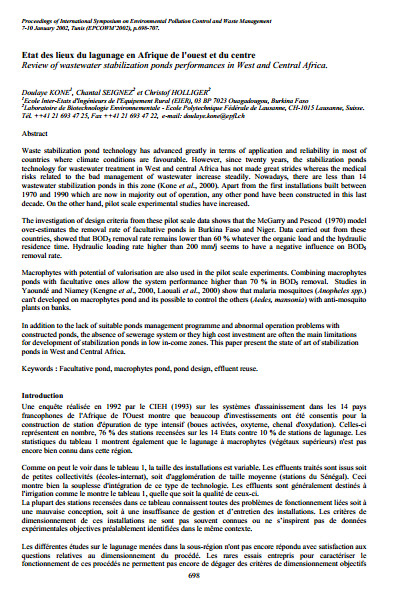Etat des lieux du lagunage en Afrique de l'ouest et du centre
 |
Review of wastewater stabilization ponds performances in West and Central Africa.
note Jan 2002 ; 10 pages
Aut.
Ed. 2iE - Ouagadougou
Téléchargeable sous format: PdF
Abstract:
Waste stabilization pond technology has advanced greatly in terms of application and reliability in most of countries where climate conditions are favourable. However, since twenty years, the stabilization ponds technology for wastewater treatment in West and central Africa has not made great strides whereas the medical risks related to the bad management of wastewater increase steadily. Nowadays, there are less than 14 wastewater stabilization ponds in this zone (Kone et al., 2000). Apart from the first installations built between 1970 and 1990 which are now in majority out of operation, any other pond have been constructed in this last
decade. On the other hand, pilot scale experimental studies have increased. The investigation of design criteria from these pilot scale data shows that the McGarry and Pescod (1970) model over-estimates the removal rate of facultative ponds in Burkina Faso and Niger. Data carried out from these countries, showed that BOD5 removal rate remains lower than 60 % whatever the organic load and the hydraulic
residence time. Hydraulic loading rate higher than 200 mm/j seems to have a negative influence on BOD5 removal rate. Macrophytes with potential of valorisation are also used in the pilot scale experiments. Combining macrophytes ponds with facultative ones allow the system performance higher than 70 % in BOD5 removal. Studies in Yaoundé and Niamey (Kengne et al., 2000, Laouali et al., 2000) show that malaria mosquitoes (Anopheles spp.) can't developed on macrophytes pond and its possible to control the others (Aedes, mansonia) with anti-mosquito plants on banks. In addition to the lack of suitable ponds management programme and abnormal operation problems with constructed ponds, the absence of sewerage system or they high cost investment are often the main limitations for development of stabilization ponds in low in-come zones. This paper present the state of art of stabilization ponds in West and Central Africa.
Mots clefs: |
assainissement (CI) (DT) (OP) , eaux usées (traitement des ) (CI) (DT) (OP) , lagunage (CI) (DT) (OP) |
Editeur/Diffuseur: |
|
2iE
-
Institut International d'Ingénierie de l'Eau et de l'Environnement - Ouagadougou - Burkina Faso |
En cas de lien brisé, nous le mentionner à communication@pseau.org